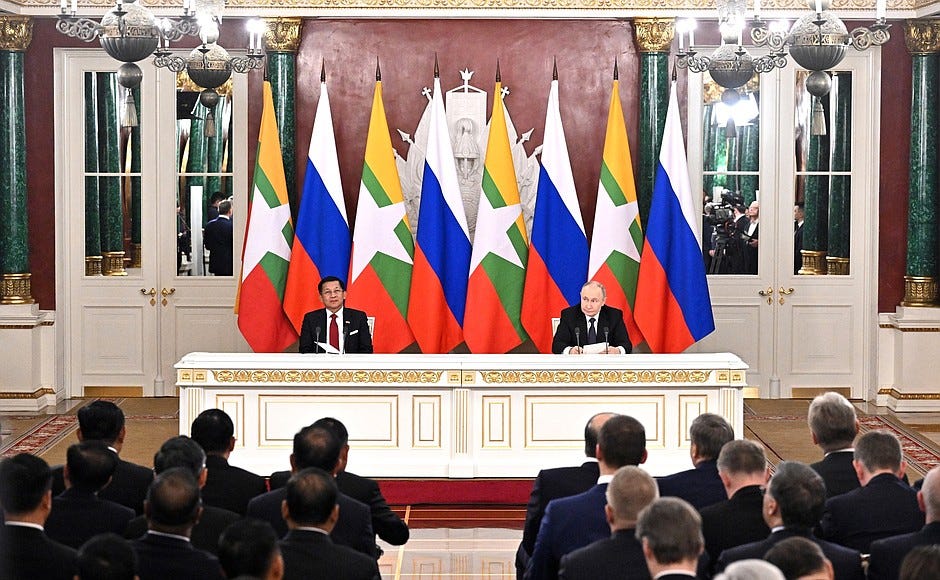New Russia Win Hype in Southeast Asia With Myanmar Summit
Plus coming ASEAN upgrades; giant defense budget push; new artificial intelligence hub; big high-speed slowdown; looming crypto framework and much, much more.
Greetings to new readers and welcome all to the latest edition of the weekly ASEAN Wonk BulletBrief! If you haven’t already, you can upgrade to a paid subscription for $5 a month/$50 a year below to receive full posts by inserting your email address and then selecting an annual or monthly option. You can visit this page for more on pricing for institutions, groups as well as discounts. For current paid subscribers, please make sure you’re hitting the “view entire message” prompt if it comes up at the end of a post to see the full version.
For this iteration of ASEAN Wonk BulletBrief, we are looking at:
Assessing the geopolitical and geoeconomic significance of new Russia win hype in Southeast Asia following a flurry of recent engagements;
Mapping of regional developments, including coming ASEAN upgrades and newly-concluded defense deal talks;
Charting evolving geopolitical, geoeconomic and security trends such a; giant defense budget push; new artificial intelligence center prospects and a big high-speed slowdown;
Tracking and analysis of industry developments and quantitative indicators including looming crypto framework; new mineral partnership; coming carbon bill and more;
And much more! ICYMI, check out our review of a new book that takes a rare, granular look at China’s soft power prospects in Southeast Asia.
This Week’s WonkCount: 2,149 words (~10 minutes)
Coming ASEAN Upgrades; New Defense Deals & More

Global South Aid Futures; Land Expansion Boom & Supply Chain Tracing
“[T]he PRC might approach a U.S. pullback or drawdown by doubling down on three existing lines of engagement: a public-private focus on a “Health Silk Road,” aid-like training and capacity building of civilian government officials and security services, and China-led leadership of South-South cooperation related to emergencies and conflict,” concludes a policy brief by AidData on how the U.S. aid freeze may impact China’s global actions. The report includes past data on U.S. and PRC financing across sectors, geographies and functions (link).
Regional Comparison Snapshot of US, OECD and PRC Development Finance (in Constant 2024 USD Billions)
“Construction land in the border areas of mainland Southeast Asia has transitioned from slow growth to accelerated expansion,” according to data in a new article from Nature. The report finds that the overall rate of so-called construction land expansion or CLE in the region has risen about 92.55 times over the last four decades (link).
Construction Land Patterns in The Border Buffer Zones of Mainland Southeast Asia
“There has also been opposition to projects and operations due to adverse and unmitigated impacts on local communities, particularly indigenous peoples, in Indonesia and the Philippines,” notes a new report by the International Energy Agency on the role of traceability in critical mineral supply chains. The report includes an assessment of traceability systems across certain countries and suggestions for a policy roadmap in this domain (link).
Visualization of Critical Mineral Traceability System
New Russia Win Hype in Southeast Asia With Myanmar Summit
What’s Behind It
Russia’s presence in Southeast Asia was in the spotlight with a flurry of recent interactions including junta chief Min Aung Hlaing’s summit meeting with President Vladimir Putin1. During the previous week, Russia senior security official Sergei Shoigu was in both Malaysia and Indonesia before his China stop, raising questions about defense inroads the Kremlin could be trying make apart from recent ones such as a first-ever naval exercise2. Just prior to that, Russia had held an exhibition playing up its civil nuclear energy and technology offerings on the sidelines of a senior officials meeting with ASEAN3. Some Western officials tracking Russia’s regional behavior have contended that there has been an uptick in Moscow’s disruptiveness in recent multilateral developments relative to China.
Recent Related Developments in Russia-Southeast Asia Relations
The meeting highlighted Moscow’s regional agenda amid shifting dynamics. Russia’s ties with Myanmar play into Min Aung Hlaing’s calculations about long-delayed polls, a source of regional anxiety which he received backing for in the Kremlin and reiterated would be held soon during his next stop to Belarus (which said it would send observers)4. More generally, a key question for Southeast Asian states looking for more “space” in their ties with Russia — as one diplomat put it — is the extent to which evolving U.S.-China-Russia triangular ties during the second term of U.S. President Donald Trump may affect Moscow’s ability to advance ties with the region and vice-versa. This future-looking question extends beyond familiar past datapoints such as BRICS membership or military hardware5.
Why It Matters
The engagement also shed light on key details in the evolving agenda and their global and regional implications (see originally generated ASEAN Wonk table below on notable datapoints and additional specifics. Paying subscribers can read on for more on what to expect and future implications in the rest of the “Why It Matters” and “Where It’s Headed” sections, along with paid-only sections of the newsletter as usual).











